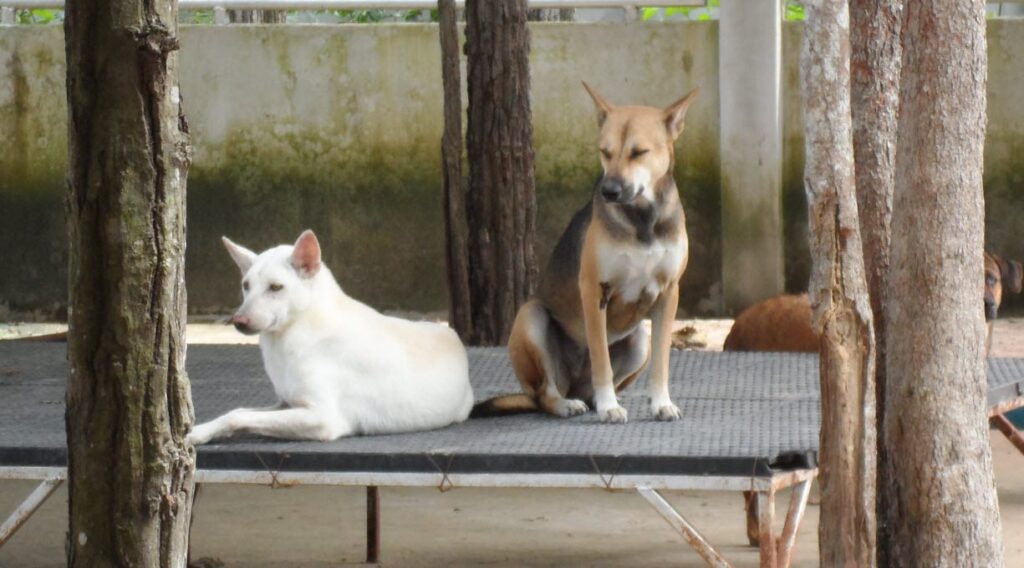At 6:00 yesterday morning, we boarded a minibus bound for Buriram with our new friends from Soi Dog Foundation and a reporter from The Christian Science Monitor. We weren’t quite sure what to expect, but four hours and several preparatory conversations later, we pulled off of the road and into what looked like a concrete city of dogs.
Anyone who has visited a full shelter knows that the first thing to greet you is the sound of barking, and the second is the smell – or at least one hopes that they happen in that order. Buriram facility had the distinct fragrance of shelter despite all the runs having been recently cleaned, but what was truly striking was the volume of the barking. Walking into the runs had the feeling of walking into a concert just as the band starts to play their most famous song, with the entire crowd roaring its excitement. With 1,500 dogs it was to be expected, but the reality of the situation was starkly different from what we had imagined.
We first walked around to the newly built adoption runs that Soi Dog uses to house the twenty or so dogs that they are promoting for adoption at any given time. These runs were notably smaller than the larger runs used for general housing, and were far less crowded. Here we met several very sweet dogs who wanted nothing more than to get a good belly rub and to give slobbery kisses for as long as you’d allow. Most of these and the dogs in general housing were female and were likely owned, or at least treated nicely by people in the past. Cristy goes to Buriram at least once a month to take pictures of dogs being promoted, to get to know them better, and to find other dogs in the general population runs that should be moved to the adoption runs or to the treatment area.
After we spent some time loving on the dogs in the adoption runs, we moved on to the larger general population runs so that Cristy and Reggie could pull a few more dogs for adoption, and take the most critically ill dogs over to treatment.
When we went through the double gates into each run, we were instantly mobbed by a herd of wiggly-tailed dogs, all vying for attention. Quieter or more submissive dogs would skirt the edges of the crowd, leery of pushing to the front for fear of being attacked by more dominant, forward dogs. Dogs not socialized with humans tended to stand or dart around the periphery of the group and bark at the two-legged interlopers. After we spent a few minutes in the runs and the dogs calmed down, the more dominant dogs who were initially at the front of the crowd tended to lose interest and fall back, and the submissive ones would inch forward to get their share of pets.
Within each run, a clear hierarchy within the packs would make itself evident fairly quickly. Higher ranking dogs tended to take the prime resting spots in the shade on higher platforms, lower ranking dogs would take spots on the floor or hide under platforms, but most dogs were in constant motion. Spats between dogs could be heard or seen every few minutes; likely the result of a lower-ranking dog overstepping its bounds, or of one of the handful of dogs that made a habit out of picking fights being obnoxious. Cristy told us that the staff tries to separate dogs into groups based on size and temperament in order to keep fights to a minimum, but that there is no way to eliminate them with that many individuals living on one space. This means that, despite the small staff’s best efforts, there are dogs in every run that are picked on, and fights happen pretty regularly.
Dogs that lived as pets rather than on the street were more likely to be targeted by the more aggressive dogs, since they didn’t understand how to function in a pack and weren’t accustomed to having to fight for resources. These are the ones that Soi Dog tries to pull for adoption first, since they tend to do better in homes, and become very stressed in a pack environment.
After we walked through all of the big runs and Cristy and Reggie moved the dogs that needed to be moved, we visited the treatment area. The adoption and treatment areas are about the same size, and contain roughly the same number of dogs. That day, there were several dogs with advanced mange, a few weak and emaciated dogs, and a handful of others with serious medical issues being housed in treatment. Dogs with skin, eye and ear issues are prevalent at Buriram shelter, as are dogs with improperly fused broken bones, and dogs with cuts and bites, so only those that require immediate attention or are unable to be treated in the larger runs are placed in the treatment area. Regular vetting (sterilization, vaccines, deworming, etc.) is taken care of before dogs arrive at Buriram, with periodic dewormings and the like performed at the shelter as needed.
Once we finished touring the shelter, we went back to the office to change clothes and wash arms and legs in order to get rid of some of the shelter smell, then we sat down to lunch. Everyone from Soi Dog who was sitting at the table said that the biggest hurdle they are encountering at this point in the fight against the dog meat trade is how to deal with the huge number of dogs stuck in the shelter. With only a few hundred adoptions per year (they’re hoping for 600 this year), it would take years to empty the Buriram facility, assuming that there are only minimal new additional residents. The sad truth is, if adoptions don’t go up significantly, most of the dogs at Buriram will stay there for the rest of their lives.
The hope is that a partnership between AFH and Soi Dog Foundation will generate some buzz in the US about the dog meat trade survivors in Thailand, and that more dogs can be taken from Buriram more quickly with groups like AFH pulling as many as their funds and fosters will allow. Dogs have a much better chance of being adopted by good families once they are out of Thailand since many folks don’t want to adopt dogs that they’ve never met, and can’t necessarily afford to have a dog sent from halfway around the world.
For us to continue getting these dogs out of Buriram, we need your help. Having flight volunteers through Soi Dog helps knock down the cost of bringing dogs to the US to a manageable amount, but it still costs money, and the dogs still need to be fostered once they arrive. Realistically, whatever the amount paid to get a dog out of that situation and into one of our wonderful foster homes, and later into an adoptive home, is worth it. More donations and willing fosters mean that we can take more dogs, and to help to ensure that the dogs who survived the horror of the meat trade know nothing but love and happiness for the rest of their lives.
Stay tuned for more updates! We’ll be adding information as it becomes available. We can’t thank you enough for your continued support!
Please visit https://www.crowdrise.com/SaveaDogfromThailand/fundraiser/afh2002 to make a donation.

